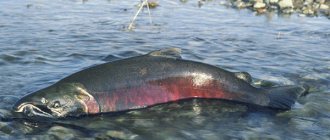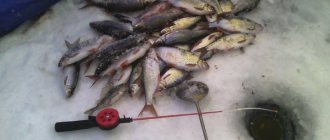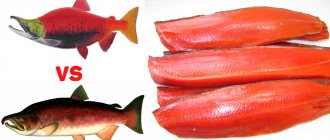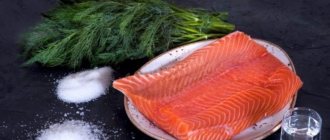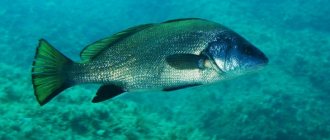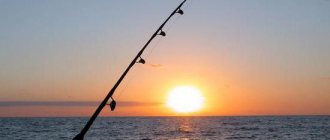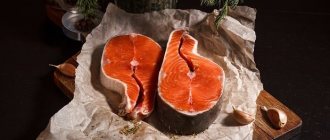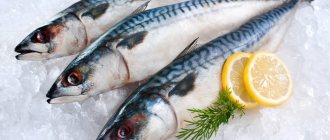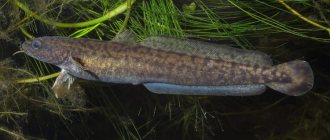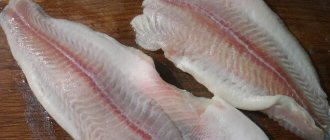One of the most popular fish among Far Eastern spinning anglers is the beautiful silver coho salmon, a Pacific salmon that sometimes grows up to 9 kg. The record specimen of our Kamchatka author Alexander Tereshchenko weighed 7 kg 100 g.
The entry of coho salmon into the rivers of Kamchatka begins in July - August and continues until December, or even later. Accordingly, coho salmon are divided into summer, autumn and winter. Summer and autumn coho salmon are interesting for recreational fishing. The summer one has light, silvery scales and a blue-green back. Autumn is painted in darker colors.
The largest run of coho salmon occurs at the end of August - September. At this time, spinning fishing is usually allowed in specially designated sections of rivers (Avacha, Bolshaya, Nalycheva).
Life cycle
Moving to the upper reaches of rivers, coho salmon change. The heads of males become larger due to the enlargement of the jaws, especially the upper ones, which take the shape of a beak. The sides turn from silver to red-brown, and the back turns black.
In the ocean, coho salmon are an active predator, but in rivers they stop feeding. However, the grasping reflex remains, so he sometimes takes the lure so greedily that without a tool it is impossible to remove it from his mouth.
Having spawned, coho salmon die. The offspring that emerge from the eggs remain in the rivers for one to two years. Yearlings have a length from 5-7 to 12 cm and weigh from 2-3 to 10-15 g.
In April - May, the strengthened juveniles begin to slide into the lower reaches of rivers and further into the ocean. The decline continues until September.
Coho salmon spend from two to four years in the ocean, but more often - three years. It fattens up, grows and, having reached sexual maturity, returns to its native rivers of the peninsula. This completes its life cycle.
White fish
Here is what S.P. Krasheninnikov wrote about coho salmon in his “Description of the Kamchatka Land” (1755):
“The last fish that runs fairly well is called white, so that it appears silver in the water. This fish differs little in size and appearance from Chum salmon. The main difference is that Chum salmon has no spots, and the white fish has black elongated spots along its back. In terms of taste, it has a great advantage over chum salmon, and can be considered the best of all the fish there that have a white body. This fish has the same properties as Nyarka, that is, it only goes into those rivers that flow from lakes; and for this purpose, near lakes and the mouths of rivers flowing into lakes, until December it hunts with nets, harbours, and locks. A one-year-old white fish, which enters the rivers with the old ones to save eggs and transport young fish to the sea, is considered by the local residents to be a special kind, and is called Mylkchuch. The old spawn has great concern for the preservation of life: it looks for deep and silty places that do not freeze in winter, goes along the springs as far as possible, and stands there until late autumn, and even until mid-winter. It is especially carried out along the springs near Bolsheretsky and Opalsky lakes, where they then hunt for it quite a lot, and eat ice cream in the winter. Along the springs flowing into the Kamchatka River from the south, especially near the place where the old lower Kamchatka fort was located, they catch it almost all winter, which serves the local residents to considerable satisfaction in food. At the end of February, I myself happened to be in those springs and see the fishing industry: however, the fish then was drier and not as tasty as the autumn fish. White fish, salted and dried, is just as tasty as fresh, and smoked meats, which a certain gentleman knew how to cook, are especially tasty. The announced fish are caught with the same nets as Keta and Nyarka. The yarn used on them is half the size of Chinook salmon, and the cells are one and a half inches long.”
Tackle
Kamchatka fishermen catch coho salmon with heavy spinning tackle. The rod must be tough enough to make a timely hook and pierce the bony mouth of the fish with a large tee. Its length ranges from 2 to 3.5 m and depends on the fishing conditions. When fishing in the bushes or from a boat, short and rigid models are often used. I use a homemade rod 215 cm long.
The reel is required to be able to hold at least 100 meters of 0.50-0.70 mm fishing line. “Neva” reels are widespread, but recently anglers are increasingly using imported spinning reels.
The use of thick fishing lines is to some extent due to the limited capabilities of the rods and reels used and the quality of the fishing line. But you should also take into account the heavy weights in the rigs and the remarkable strength of large coho salmon.
With a good bite, the roughness of the tackle does not affect the result. As an experiment, I tried fishing with a 0.90 mm fishing line, and instead of a coho lure with a 10 mm tee, use a chinook spoon with a 14 mm tee. The coho salmon were excellent.
The spinners most often used are rotating, light ones. The spinner is on a leash 60-75 cm long, connected to the main fishing line through a “yoke”. A shorter leash (35-50 cm) with a heavy (60-150 g) conical lead sinker is tied to the other end of the “yoke”.
Chinook lure (left), coho lures, sinkers and “rocker arms”
Naturally, the fishing line used for leashes is thinner than the main line.
The “yoke” is made of steel wire with a diameter of 0.8-1.2 mm. The improved rocker arm, which prevents the leads from overlapping when casting, has a hinge arranged using a bead.
In sections of rivers with relatively calm flows, they also fish with heavy, oscillating spoons.
The color and size of the spoon play a role mainly when the bite is bad. The most commonly used are white polished spoons, yellow ones (especially good in sunny weather), combined colors (for example, one side is yellow, the other white) and red (copper).
Where to catch coho salmon
Coho salmon is a schooling fish; large numbers can be found in holes, in quiet places with a slow, even current and shelters at the bottom. Despite their abundance and high concentration in one place, the activity of coho salmon gradually decreases by the time of spawning.
I remember one case when we stood on a high cliff above a hole in which at least 40-50 fish were visible in an area 15-20 m long. My partner stood below and changed the fly every two trips, trying to seduce at least one coho salmon so that take a beautiful photo, but it was all in vain. Only two fish showed curiosity about the baits on the first two casts, but they never dared to attack the flies and returned to their place in the school. Every single fish was in cherry breeding plumage and ready to spawn, which is perhaps why they were little interested in everything that was happening in front of their noses.
If, while on the river, you are aiming to catch coho salmon, be sure to fish all the holes with reverse currents and border streams. Places under steep cliffs are very promising, but fly fishing here is not very comfortable, since it is difficult to find a convenient place to cast over a more or less decent distance. The places where the ducts exit may be interesting. As a rule, merging with the main stream of the channel, the flow in the channel greatly weakens, slows down, and a large hole can form here, in which coho salmon will certainly linger. The problem with such holes is that the fish stop here during their many-kilometer climb up the river. Therefore, if you catch a coho salmon in this place today, know that tomorrow there may only be mykiss, which replaced it. But you shouldn’t forget about this place, since the next flock may arrive in a day.
Make it a rule, at least in the first days, to look for fish in all promising points until you understand where on the river there are passage holes and where the main parking holes are, since coho salmon are in constant motion. Places with weakened currents below the pebble spits in the main channel may be promising. Here, as a rule, fish stop during the passage, but even in the absence of coho salmon in such places, the rest of the inhabitants of the reservoir will not let you get bored. At one section of the river, I discovered an interesting feature: a small island had washed up in the middle of the riverbed. To the right of it, the main channel with a very strong current and a completely flat bottom did not attract anyone; on the left there was a narrow shallow channel, in which, as it merged with the main channel, the flow slowed down and a deep hole formed, and over it hung the branches of trees growing at the very edge of the water. In this hole for several days I was able to catch large mykiss well, since there were many hiding places for the cautious predator.
In order not to scare the fish, I approached the place on the right side of the island along the main channel and, just in case, while walking to the hole, I made several control casts. That day, on the stream while approaching the hole, my fly was grabbed by a standard-sized coho salmon, which immediately dived into the main current, exposing its wide side to the flow of water, due to which it was immediately carried away about 30 m. I had to work hard before the fish was freed off the hook, she found herself back in her native element. I didn’t immediately attach much importance to this, but I was surprised that the fish ended up in a place that was not entirely suitable for its holding. However, it later turned out that the mykizha hole that day was occupied by coho salmon, which did not miss a single one of my flies. The next day, I decided to catch coho salmon in this hole in order to take good photos with it, but I only managed to extract a couple of weighty mykiss, and a couple of the same ones landed right at my feet. Then it became clear that a passing school of coho salmon had chosen the hole for some time, and all the fish that did not have enough space there continued to climb up the main channel, where I caught one of them.
Fishing technique
When fishing from the shore, casting is performed perpendicular to the shoreline. When the load touches the bottom, they begin to gradually release the fishing line, maintaining constant contact with the spoon and “listening” to its work. As soon as the tension weakens, the line stops altogether. The current continues to carry the spoon along an arc. If the sinker rises with the current, you should, on the contrary, release more fishing line.
Bites usually occur with a “standing” sinker.
If they are gone within one to two minutes, you can begin to slowly reel in the fishing line. This is also a very favorable moment.
When fishing near steep banks or in deep pools with weak currents, slow retrieval is continued until the very end. The bite can occur literally a meter from the shore, a few steps from the angler. So you should always be prepared to meet a silver predator. When fishing from a boat, after casting and putting the spoon into operating mode, do not rotate the reel, but simply wait for a bite. By the way, it has long been noticed that coho salmon are more willing to take a standing spoon.
What are the benefits of coho salmon?
Due to its high nutritional content, coho salmon meat (including ice cream) has multidirectional therapeutic and preventive effects:
- heals the musculoskeletal system;
- reduces the number of exacerbations of osteochondrosis, arthritis, arthrosis, gout, forms articular cartilage, strengthens tooth enamel;
- normalizes the activity of the central nervous system and cardiovascular system;
- strengthens the walls of blood vessels, improves blood composition;
- normalizes metabolism, accelerates metabolism;
- increases resistance to respiratory viral diseases;
- When consumed regularly, it promotes the formation of muscle tissue and reduces visceral fat deposits.
The substance contained astazanthin is a strong antioxidant. It removes radionuclides, heavy metals, and protects cells from malignant degeneration. Coho salmon fillet recipes can be successfully added to dietary nutrition and weight correction at home.
You should not buy and cook coho salmon if you have kidney pathologies or allergies to fish proteins. The fillet contains coarse fibers: if you have gastrointestinal diseases, you will have to give up even simple recipes.
Prohibited method
It is on this feature that the tackle is based, which is popularly called “bultykh” or “thunderer”. Despite the fact that it is prohibited by Kamchatrybvod, local residents willingly use it, especially on the Avacha River. While spinners on Avach often remain empty, waving their rods from dawn to dusk, they often land two or even three fish at a time on the “bulls”.
A lead casting weighing one to one and a half kilograms is tied to a 25-30-meter piece of 0.80-1.0 mm fishing line. To make casting easier, a half-meter piece of rope is tied to the same casting. Up from the load, at intervals of about 2 meters, half-meter leashes are tied to the fishing line, slightly thinner than the main fishing line, up to five pieces! On each leash there is a light rotating spoon. The free end of the fishing line is tied to a stake on the shore.
The “structure” is carefully laid out on a section of the shore cleared of debris, checked to see if the leads are overlapping, and, like hammer throwers, make a cast. You need to throw it so that the whole tackle stretches and flops into the water.
Bultikh! - A cloud of splashes, but the job is done. The line goes into the water at a slight angle to the shore. Now just watch. If the line “creeped” or a coho salmon jumped out, it means there was a bite. And then it’s a matter of technology.
Secrets of culinary processing of coho salmon fish
When removing scales from a frozen coho salmon carcass, do not work too actively with the knife.
Smooth movements of the blade are enough to completely remove the scaly coating. The juiciest meat of the Salmon species is stewed or baked. Alcohol and hot pepper in cooking recipes will spoil the taste of the finished dish. Frozen fish fillets are not marinated for a long time. Before preparing coho salmon, the carcass is salted, flavored with herbs, kept for 15 minutes and followed by your favorite cooking recipes. Steam/fry coho salmon fish “by the clock” - the recommended time cannot be exceeded. Return to list
Oscillating spoons
In reservoirs with weak currents or in the lower reaches of rivers during high tide, heavy oscillating spoons and even stainless steel spoons are often used (I tried it myself). The handle is pre-sawed off. A 10 mm tee is attached to the wide edge of the spoon through the winding ring, and a carabiner is attached to the place where the handle began. For example, residents of the village of Sovetsky fish with spoons, mainly due to the inability to legally fish on the Paratunka River, next to which they live. The spoon is heavy and can be cast by hand, without a rod and reel. With “manual” wiring, the spoon, yawing, goes half a meter to a meter from the surface. Sometimes you can even see how a predator attacks her. Having noticed something suspicious or heard a motor, the poacher quietly retreats into the bushes, leaving a fishing line previously tied to a peg on the shore.
For Sakhalin coho salmon...
Dear Countrymen, Forum members, I bring to your attention one of the stories from Sakhalin fishing...
Surely many of you took part in more interesting and exciting trips and felt the incredible beauty and dynamics of the bites of worthy opponents... I also had to get acquainted with something on Sakhalin... I would like to share with you one of the most interesting fishing trips for Sakhalin coho salmon - one of the species of salmon ... It is possible that many are familiar with this trophy ...
Sometimes lovers of Far East Nature contact me online, who want to get to know it in reality... When it’s convenient for me, I take part in such “adventures”... This is not hidden advertising, I am very “picky” in choosing travel companions... 

Sakhalin, September...
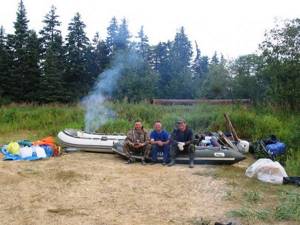
My friends and I arrived at the taiga coho river a few days before the group’s arrival to prepare the winter quarters for the arrival of guests... Here we have communicated more than once in summer and winter. As a rule, we were always happy with fishing and hunting...
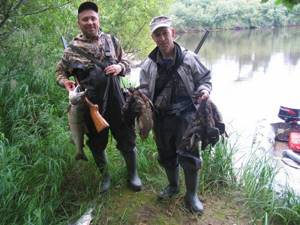
We alternated camp-wide landscaping work with fishing and duck hunting. The goose had not yet moved south, but there was quite a variety of duck in the meadow with small lakes. Therefore, we did not worry about real fishing and a successful hunt... It was just that my reliable friends, along with the vacation, helped to organize the upcoming life in the camp for themselves and our guests in a timely and efficient manner.
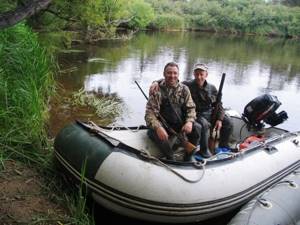
Meeting in Nogliki...
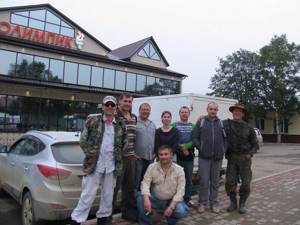
The group has already visited many interesting places in Russia: Karelia, Kamchatka, Siberia, etc., only Sakhalin Island remained unexplored. Moreover, the guests had already purchased tickets a long time ago, but wanted to relax at the base camp and go fishing every day... We met in Nogliki, loaded into a very comfortable 8-seater passenger-truck, visited the local mini-market and purchased all the necessary products. The guys noted the affordable prices and politeness of the staff, and with their purchases they helped fulfill the weekly plan for selling products... The store managers were especially pleased with the purchase of 40 liters of Russian Standard, thus supporting the domestic EU sanctions.
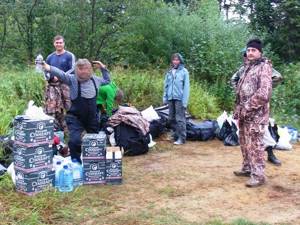
The guys got serious just by request: 40 liters of “Russian Standard” for a week for 6 men...
IMHO, THIS IS COOL! This is according to our, even Sakhalin standards...
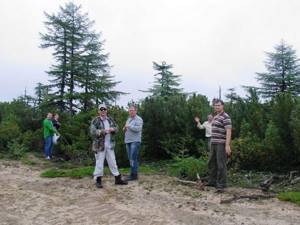
Nuts for free...
On the way, we stopped near a dwarf cedar tree to pick up some nuts; we immediately saw fresh tracks of a small bear, which immediately gave the group some adrenaline. Everyone scrambled for their Canons and Nikons, hoping to immediately see the owner of the Sakhalin taiga. Alas... Obviously, this owner ran away just in case, hearing the enthusiastic “screams”... When several mosquitoes and a dozen midges appeared, the guys urgently put on their mosquito nets... By and large, the “bloodsuckers” usually end their season at this time. Obviously, they decided to show their activity and demonstrate interest in the “Muscovites”...

While they were unloading, a cool SUV pulls up, it’s clear that the locals...
An unexpected meeting: Shchukar HIMSELF came for coho salmon fishing...
Who still doesn’t know Shchukar in the South - throw him at that dead bull...
He has his own store selling fishing tackle, he himself is a decent fisherman according to local “concepts”, he constantly travels to the north specifically for coho salmon fishing.
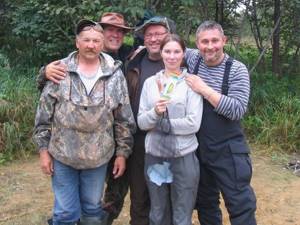
By the way, Shchukar showed the “Master Class”, and while we were unloading, he caught a magnificent female coho salmon... It would be unreasonable not to take a photo with him and ask for practical advice. Shchukar generously and with dignity gave the only lady in our team the most “catchable” spoon... Our lady later “shoed” all the men in one “wicket” with “iron” from a Sakhalin native...
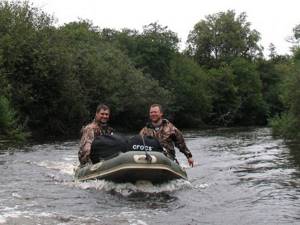
The road to the base camp was not difficult and not burdensome... Soon we were already at the base.
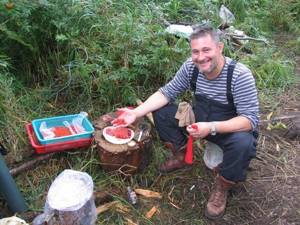
My Sakhalin friends “hurried up” with caviar and fish for the arrival of the guests...
These are tampons, please do not confuse them with “Tampaxes”... It didn’t come to them...
For the uninitiated: fishing with fresh caviar tampons is one of the most “delicious” baits for almost all Sakhalin fish. If it doesn’t take on hardware, wobblers, etc. try it on tampons - you won't regret it...
In the following days, Kuzhuch took more hardware confidently and angrily... It was only necessary to find the place where he was...
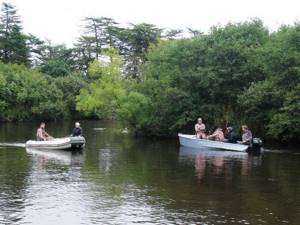
According to a preliminary application, the fishermen were provided with 3 motor boats, thereby achieving complete autonomy when fishing. Each group chose its most catchy and “cool” place... Mostly sea rudd took the spinning rod, occasionally kunja and char, silver coho salmon was the most worthy trophy. Of course, after a photo session, salmon were usually released into the wild, with the exception of a few individuals that, during fishing, acquired irreversible damage to their organs... I had to “consume” this fish for food...

Alex (the unofficial “Führer” of the group), constantly took care of the complete and qualified nutrition of his colleagues... In this northern region of Sakhalin, EU sanctions did not play any role at all... When we cut this magnificent bird into its component parts, the question arose: What kind of soup are we shall we cook? To feed the whole group... It is Alex's merit that all his colleagues did not gain weight, but “lost weight” by several kilos... But THAT is a different story...
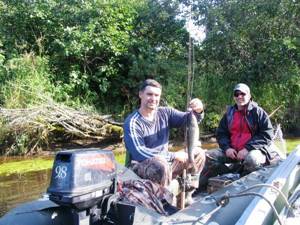
Sometimes the sea rudd greedily grabbed the spoon... This fish (up to 1-2 kg, by the way, sometimes) is very tasty, although bony. A good “fighter” for any tackle.
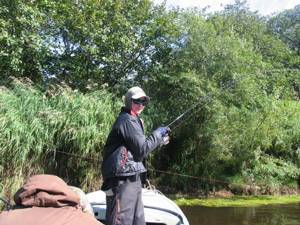
And then the real fishing itself began...
The “Shchukar” iron worked... If IT had not been donated, there would have been a complete collapse... Just kidding. All fishermen had a solid supply of spinners and wobblers, which sometimes even tempted Sakhalin taimen, which were immediately released into the wild.
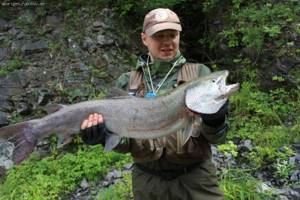
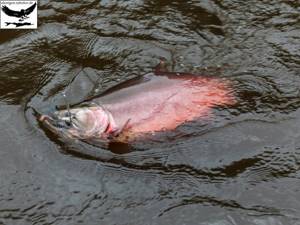
As a rule, our friends did this promptly and carefully, and therefore did not spend much time photographing the relict fish so that it received minimal stress from being caught...
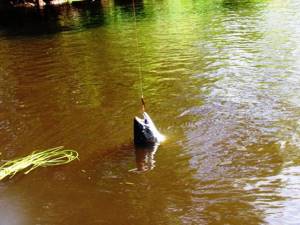
Sometimes some large fish encroached on the “iron”. As a rule, there was a short struggle, then a retreat... Surely, it was the Sakhalin taimen who encroached on the “pieces of iron”...
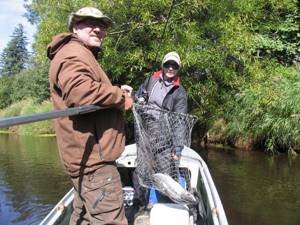
But often it came down to the “cacher” (landing net)… This particular married couple was especially different.
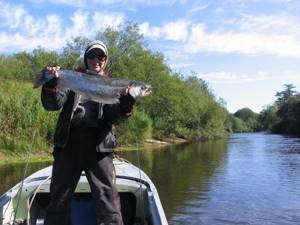
Here it is, trophy coho salmon, for which many people travel thousands of kilometers into the “darkness of the cockroach” in order to feel the real bite of trophy salmon... For such people there are no long distances and difficult roads. Such an amazing bite can only be felt on Sakhalin, Kamchatka or in the KhBR Territory... Good luck if you have reliable companions nearby who can help with advice and practical assistance...
This magnificent and very strong fish can also be caught using fly fishing gear...
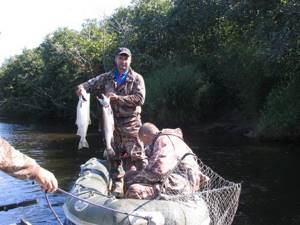
Ordinary “situation”...
The guys got caught in the coho salmon grater...
For those who are not familiar with this terminology, let me explain: in the Khbr Region this is the name given to the place where salmon lay their eggs. On Sakhalin, this is just a stretch for spawning... If you guessed this place, consider that you have caught the bird of Luck... The first days of DIMON (on the right in the photo) not everything worked out... When he “caught” on the tail of Luck and caught the first few coho salmon of 4-5 kg weight, Dimon calmed down a little... At first he said: “I would rather compete with 5 pikes than with one coho salmon”... The guys slightly joked at him that Dima rarely goes fishing lately...
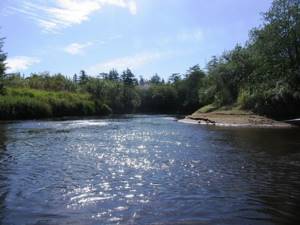
However, without sentimental “snot”, I liked our lady most of all... I was lucky enough to be present at her successes and real “triumphs”... When you say: Try here... Perhaps there will be a bite... A couple more tips on retrieving, casting, "tyrs" - spin in arc, dancing on the water... Wrestling, in a “serious” way, everything is done correctly: 45-50% of the spin in relation to the surface of the water, a pre-adjusted brake, a “wattle” on the reel... The main task is not to let the enemy go into “free” swimming... If it gets into the bushes, it’s a “tryndets”, the fish is strong, it has just come in from the bay, so good luck if you control the situation to the limit... It’s good if there is a lot of water, here is a special case: Strong fish, little space, high-quality spin, etc.
In addition, I was happy to provide her with a short fly fishing lesson...
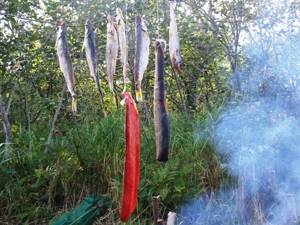
And this is the famous catfish that the local aborigines treated us to and the semi-smoked chinook salmon purchased by our friends in Yuzhno-Sakhalinsk. By the way, the meat of this wonderful fish was the cause of mass poisoning of all (without exception) fishing participants... For some, this poisoning caused severe diarrhea, for others, the temperature rose, for others, their mood simply deteriorated for a day or two... For me, oddly enough, this “event” was expressed in a light “chair”... Obviously, the Sakhalin hardening had an effect...
Poisoning was also the reason why the box of “fire water” turned out to be “not drunk”... 

Summary:
All tourists are not recommended to buy products of dubious quality at any local market...
Otherwise, similar problems are possible that can ruin your entire vacation...

I had to unfortunately just pour all the remaining good quality vodka into the river... ;-(
If the guys want, they will share their impressions that they received on Sakhalin...
Surely, they have seen “cooler” fishing, that’s a fact... But there is little that can compare with Sakhalin fishing...
I’m telling you this for sure...
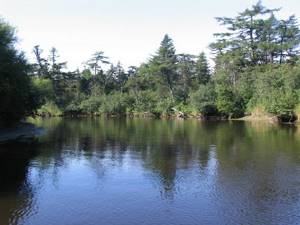
It’s already near the mouth...
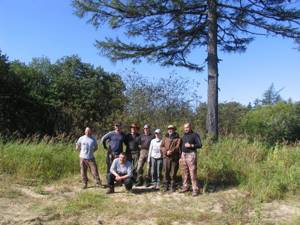
Photo for memory…
It was cool... I hope everyone was very pleased...
Perhaps these people will come back here more than once...
